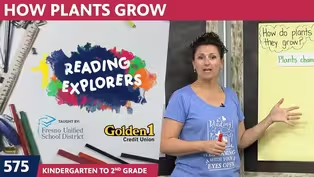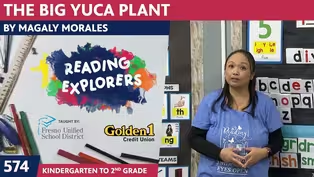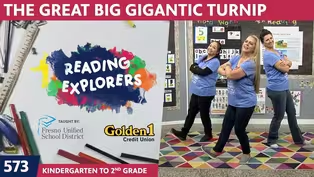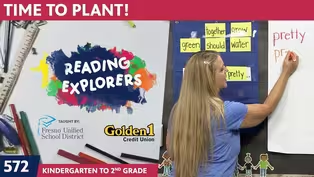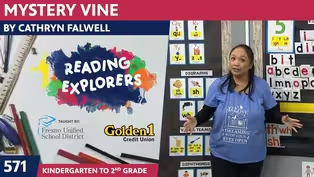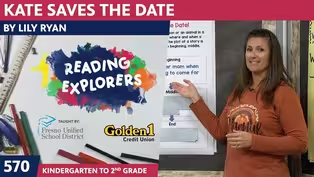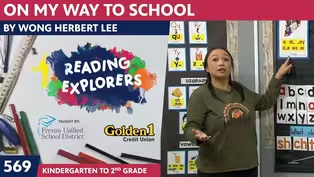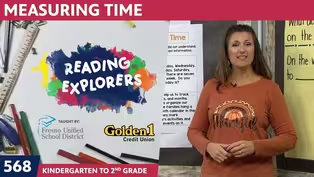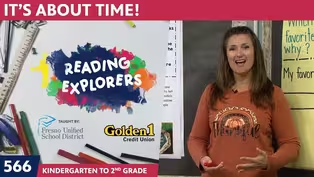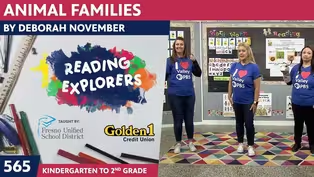
3-346: Closed Syllable Types
Season 3 Episode 256 | 14m 17sVideo has Closed Captions
Join Mrs. Nix at Camp Discovery!
Third Grade teacher, Mrs. NIx, welcomes students back to Camp Discovery, a fun learning space packed with reading adventures & fun games!
Problems playing video? | Closed Captioning Feedback
Problems playing video? | Closed Captioning Feedback
Reading Explorers is a local public television program presented by Valley PBS

3-346: Closed Syllable Types
Season 3 Episode 256 | 14m 17sVideo has Closed Captions
Third Grade teacher, Mrs. NIx, welcomes students back to Camp Discovery, a fun learning space packed with reading adventures & fun games!
Problems playing video? | Closed Captioning Feedback
How to Watch Reading Explorers
Reading Explorers is available to stream on pbs.org and the free PBS App, available on iPhone, Apple TV, Android TV, Android smartphones, Amazon Fire TV, Amazon Fire Tablet, Roku, Samsung Smart TV, and Vizio.
Providing Support for PBS.org
Learn Moreabout PBS online sponsorshipMore from This Collection
Valley PBS and Fresno Unified School District have partnered with Golden 1 Credit Union to create Reading Explorers Lessons for grades Pre-Kindergarten through Third grade. The daily lessons will be taught by Fresno Unified School District teachers and are created to help students practice their reading skills and reinforce lessons during distance learning.
Video has Closed Captions
Learn about the life cycle of a plant on Reading Explorers. (26m 39s)
K-2-574: The Big Yuca Plant by Magaly Morales
Video has Closed Captions
Join the Reading Explorers as we adventure into a new book The Big Yuca Plant. (26m 30s)
K-2-573: The Great Big Gigantic Turnip
Video has Closed Captions
What will happen at The Great Big Gigantic Turnip? (26m 30s)
K-2-571: Mystery Vine by Cathryn Falwell
Video has Closed Captions
The Bell has rung and the Valley PBS Classroom is open once more. (26m 32s)
K-2-570: Kate Saves The Date by Lily Ryan
Video has Closed Captions
Mrs. Nix, Mrs. Hammack and Mrs. Vang are glad to have you join her for a new day. (26m 32s)
K-2-569: On My Way To School by Wong Herbert Lee
Video has Closed Captions
Mrs. Vang is ready for a new day of phonemic awareness and reading comprehension. (26m 40s)
Video has Closed Captions
We review phonics, frequency words and more on Reading Explorers. (26m 45s)
K-2-567: Nate The Snake Is Late
Video has Closed Captions
What happens when Nate the Snake is late to school? (26m 49s)
Video has Closed Captions
It's time for school! How do you know what time it is? (26m 31s)
K-2-565: Animal Families by Deborah November
Video has Closed Captions
Welcome to the Reading Explorers lessons in the Valley PBS Classroom. (26m 14s)
K-2-564: From Caterpillar To Butterfly
Video has Closed Captions
The transformation from Caterpillar to Butterfly is a special one. (26m 52s)
Providing Support for PBS.org
Learn Moreabout PBS online sponsorship♪ Good morning to ♪ ♪ A brand new day ♪ ♪ Time to learn and games to play ♪ ♪ Learning things is so much fun ♪ ♪ Learning is good for everyone ♪ (upbeat music) - Good morning, third graders.
My name is Mrs. Nixon.
I am so excited to be here with you today to support you in becoming amazing thinkers, readers, and writers.
I have a story that I would love to share with you and it's all about perspective.
Because if you can imagine a creature, coming into a new village and nobody could see it and they just had to feel it, how do you think that they would describe it?
Hmm, lots of different perspectives.
And so if that's something that you would enjoy reading about.
"Elephant in the Dark," is a book just for you.
And it's based on the poem by Rumi.
So you can check this book out, either through your local County library or go online and check it out with Sora.
Now, speaking of Sora, we love to celebrate our schools here in Fresno Unified that are checking out books using Sora.
And we do a countdown of the top five schools that are the top checkout schools.
So let's check out who is in that fifth position this week.
And if I turn it over, I'm gonna see it's Birney Elementary, our little Birney Bears.
So great job, Birney.
So proud of you for checking out those books and becoming amazing readers.
All right, speaking of readers and getting our minds to be working fantastically, I wanna put a little plug in here at PBS.
We love to share these fun activity workbooks.
They're totally free.
All you need to do is, see that address that's popping up on the screen.
You just send me a note, let me know your address and I'll make sure that one of these get put in the mail for you at home.
And it's totally free.
There are word searches and puzzles and all sorts of games and it's totally free.
All right.
Are we ready to start today?
We've got three things that we're gonna go through.
We're gonna start out by looking at common roots, closed syllables and context clues.
Are you ready?
Let's warm up that super smart muscle that you've got, your brain.
I've got some high frequency words for us to practice this week and let's go through and read them together.
Here we go.
Would, should, yellow, years, your, you're, write, right, laugh and does.
Hmm, some of those words sounded the same.
Do you remember what those were called?
That's right, homophones.
We'll get to them as the week continues but if there is a word up here that you think to yourself.
Hmm, I don't know how I would use that in a sentence or I'm not sure how to spell it.
That's okay.
It's all about your being in control of your learning success.
So jot it down and practice it throughout the week.
Okay, I have two words.
We're gonna look at today.
I have would.
W-O-U-L-D and should.
S-H-O-U-L-D. Now, would is really just the past tense of will and should has a little bit more obligation to something, you can kind of use them interchangeably but remember, should is a little bit more of a obligation.
Okay, let's use them in a couple of sentences.
The bus driver told us which bus we, hmm.
Take.
So really we could put either one of them and that hmm, be very helpful.
Okay, so if there's an obligation, probably our bus.
So the bus driver told us which bus we should take, probably because that's the one that we should be doing, right?
And that would be very helpful.
It's very helpful when a bus driver can let us know which one we should be taking, right?
Excellent job.
All right, third grade, let's go down.
Let's start talking about these common routes that are here.
Now, common routes are simply that smallest piece of our word.
And by knowing what those common roots are what the meaning is, we can then expand our vocabulary and we can understand what other words mean.
So let's look at an example here.
So I've got three words, react, action, and active.
So do you see a word part in here that's the same in all three?
Awesome, it should be act.
So if I cover it up just right here, you can kind of see it.
React, I've got A-C-T, action and active, right here.
And if I know what act means, act means do or go.
And that makes sense because when I think about these three words, react, action and active.
I know that it has something to do with doing.
I'm very busy with something.
Now, here's another example.
I've got telephone and television.
Do you see a word part that's the same in both of this words?
Excellent, it should be that tele.
T-E-L-E.
So you can see that in both of our words.
And that simply means it's far off, a far or at a distance.
And that makes sense too.
So we use a telephone to talk to people who are far away and we watch the television that has people that are far away.
They're not necessarily in our home.
So we're gonna look today for some common routes.
Okay, let's go through our next thing that we're gonna talk about today.
Are syllables.
Now, remember back, way back in August when we started talking about syllables, we talked about that there are actually six different syllable types.
And the one that we're gonna focus on today is the closed syllable.
So I brought up this poster just so that we could kind of remember there's lots and lots of different ones that we have, but we're gonna talk about the closed syllable.
Things to remember with that closed syllable.
Well, when we have a closed syllable the vowel sound is short.
Okay, let's look and see what that means.
So when I come to a word and it could be any type of word, this is a great example.
The first thing that I wanna do is that I wanna find my vowels.
Do you remember vowels?
A-E-I-O-U.
Perfect.
Okay, so let's look and see, do we see any vowels?
Okay, I see two of them right here.
So there's an A and an E. I'm gonna put a V for vowels at the top just so that I can remember.
Now, look at my letters that are in between.
I'm training my brain to see this.
And I see that there are two consonants.
Now, any time I have this pattern where I've got this vowel, consonant, consonant, vowel.
I know I can split my syllables right between my consonants.
And then, I'm gonna have short vowels in both.
And these are closed because it's followed by this consonant.
And I know because I've got that consonant, my vowel is short.
So if I were to sound this out, I would say magnet.
Magnet.
It helps us when we're going through and we're sounding out our words.
Okay, now remember every word has or every syllable has a vowel sound.
Let's try it again.
Let's look for our vowels.
Do you see them.
A-E-I-O-U.
So I see a U and an E. So those are my vowels.
Do I see any consonants?
Yap, I've got two of them.
It's a double M. That's really easy.
My brain really can see that one but I'm gonna split my syllables.
I've got two syllables, two vowel sounds, two syllables.
And they're gonna be short because they're closed with a consonant.
So, summer.
Okay, last one.
I know that you're starting to see that pattern.
Great job.
Let's look for our vowels, a U and an E. Just like that.
are you doing it with me at home?
Oh, you're amazing.
Okay, two consonants.
I'm gonna put C's for my consonance.
Split between my C's.
I've got two syllables.
They're closed syllables because they've got a consonant after the vowel.
So they're gonna be short, number.
Number, excellent job.
Okay, so let's look and see what this is look like in our practice books.
Okay, so we're gonna go through we're gonna start right with those syllables.
So looking here, we're gonna read each of the words and then what we wanna do is, did it get divided correctly?
So look here.
We've got the word rabbit.
Okay, how are we gonna split it?
Do you remember what I said to do first?
Yes, look for the vowels.
Okay, so I've got a vowel here and a vowel here.
So how many syllables am I gonna have?
I'm gonna have two.
And if you did it just like this on your paper or on your whiteboard, you could be practicing it too.
You've got two consonants right there.
So then I know I'm gonna split those consonants.
So rabbit, which one's done correctly?
Right here.
Do you see it?
Nicely done.
Okay, let's try one last one.
We've got chapter, chapter.
Okay, find those vowels.
A and E. So I'm gonna mark them with a V so that they're my vowels.
Let's look and see.
Do we see any consonants in between?
How many of them?
One, two.
Yap, vowel, consonant, consonant, vowel.
Where do we split our syllables?
You got it right down those consonants.
So we've got chapter, which one's done correctly?
Yes, chapter.
Excellent job.
Let's go down here and we're gonna look for those common routes.
So it says, read each pair of the related words.
Underline the common root or the base word in each of them.
So looking at this first one we have enjoyment and joyful.
Do you see a word part that's the same in both?
Excellent, right there.
Joy here and joy here.
So it's about happiness.
All right, let's do one last one right here.
We've got musical and musician.
Do you see a word part that's the same in both?
Yes, I see the word music right here.
So what do you think both of these words have to do with?
That's right, they both have to do with music and so you can help figure out what those words mean in context when you know those little word parts.
Okay, so here's our last part that we're gonna finish up today.
We're gonna talk about some context clues because authors are always trying to give us a little bit of information.
I have a sentence here.
We're gonna see if we can figure out, using the rest of the words around the sentence to help us figure out what that meaning is.
So let's read it together.
Big and loud.
So there are many volunteer groups who provide assistance or relief to people in need.
Okay, what does the word relief mean?
Well, if I back up just a little bit, there are many volunteer groups who provide assistance or relief.
There's a little context clue.
So when they have or I know that assistance and relief mean about the same thing.
So does it mean that I have maps or help?
That's right.
Relief is help.
They provide help.
Excellent job.
So today I just wanna say, thanks for hanging out with me as you're getting ready for school.
And remember you are responsible for your learning success.
So listen, ask questions and share your ideas because together we can do so much more.
Have a great afternoon.
I can't wait to see you back here tomorrow on PBS have a good one.
(upbeat music) ♪ Good morning to ♪ ♪ A brand new day ♪ ♪ Time to learn and games to play ♪ ♪ Learning things is so much fun ♪ ♪ Learning is good for everyone ♪
Support for PBS provided by:
Reading Explorers is a local public television program presented by Valley PBS
